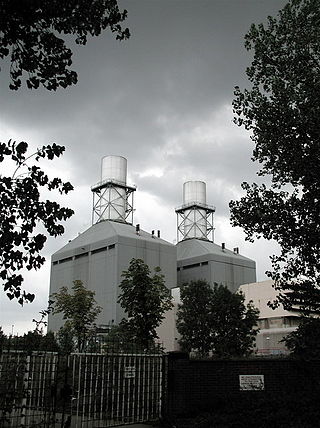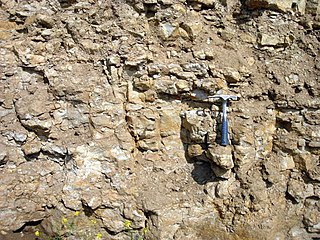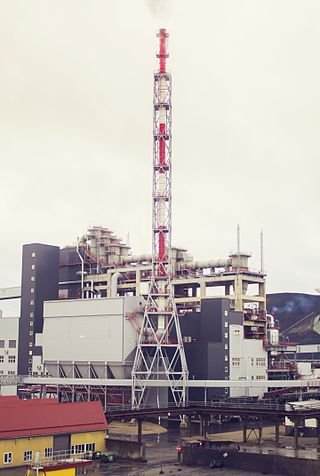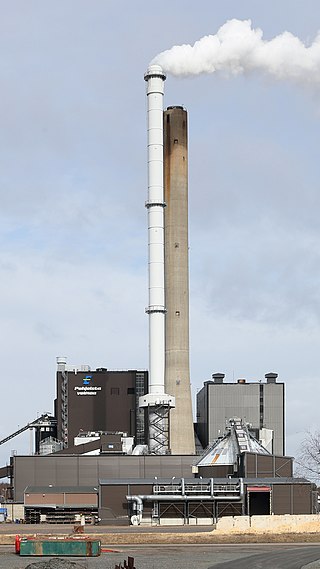
Eesti Energia AS is a public limited energy company in Estonia with its headquarters in Tallinn. It is the world's biggest oil shale to energy company. The company was founded in 1939. As of 2014, it operates in Estonia, Latvia, Lithuania, Finland, Jordan and Utah, United States. In Estonia, the company operates under the name Eesti Energia, while using the brand name Enefit for international operations. The main raw material for energy production – oil shale – is extracted from mines located in Eastern-Estonia and owned by the company. The group of Eesti Energia has three main operation areas: electricity generation, shale oil production, and sale and distribution of electricity. Its shares are owned by the Government of Estonia.
Enefit Kaevandused was a mining company located in Jõhvi, Estonia. It was a subsidiary of Eesti Energia, an Estonian state-owned energy company. The core activity of Enefit Kaevandused was oil-shale mining. The produced oil shale was mainly used for shale oil production and to fuel oil shale-fired power stations in the north–east of Estonia. As of 2009, the company has 3,150 employees. The last chief executive officer was Andres Vainola. The company produced more than 17 million tons of oil shale in 2013.
Viru Keemia Grupp (VKG) is an Estonian holding group of oil shale industry, power generation, and public utility companies.

Zaporizhzhia thermal power station is a large non-nuclear thermal power plant (DRES) in the purpose-built city of Enerhodar in Ukraine that was built by the Soviet Union between 1971 and 1977. It is the most powerful thermal power station in Ukraine, with an installed capacity of 2,850 MWe. Its primary fuel is coal; it can also fire natural gas and fuel oil, and has tank storage for these reserve fuels adjacent to the coal bunkers.

Little Barford Power Station is a gas-fired power station just north of the village of Little Barford in Bedfordshire, England. It lies just south of the A428 St Neots bypass and east of the Wyboston Leisure Park. The River Great Ouse runs alongside. It was formerly the site of two coal-fired power stations, now demolished. The station is operated by RWE.
Attarat Power Plant is an oil shale-fueled power plant under construction in the Attarat Um Ghudran area, 50 kilometres (31 mi) east of Al Qatranah in Jordan. The project is developed by the Attarat Power Company (APCO), a partnership between YTL Power International (45%), Guangdong Energy Group Co., Ltd. (45%) and Eesti Energia (10%). It is the first oil shale power plant in Jordan and the largest private sector project in Jordan to date.

Oil shale in Jordan represents a significant resource. Oil shale deposits in Jordan underlie more than 60% of Jordanian territory. The total resources amounts to 31 billion tonnes of oil shale.

There are two kinds of oil shale in Estonia, both of which are sedimentary rocks laid down during the Ordovician geologic period. Graptolitic argillite is the larger oil shale resource, but, because its organic matter content is relatively low, it is not used industrially. The other is kukersite, which has been mined for more than a hundred years. Kukersite deposits in Estonia account for 1% of global oil shale deposits.

Narva Oil Plant is a commercial scale shale oil retorting facility located in Auvere near Narva, Estonia. The plant produces shale oil from oil shale by using Galoter/Eneffit technology. The facility belongs to Enefit Energiatootmine, a subsidiary of Eesti Energia.

The Galoter process is a shale oil extraction technology for a production of shale oil, a type of synthetic crude oil. In this process, the oil shale is decomposed into shale oil, oil shale gas, and spent residue. A decomposition is caused by mixing raw oil shale with a hot oil shale ash, generated by combustion of carbonaceous residue (semi-coke) in the spent residue. The process was developed in 1950s and it is used commercially for the shale oil production in Estonia. There are projects for further development of this technology and for expansion of its usage, e.g. in Jordan and USA.

The Toppila Power Station is a power station in the Toppila district in Oulu, Finland. As of 2019 it is one of the largest peat-fired power stations in the world, with an installed capacity of 210 MW of electric power and 340 MW of thermal power. The facility operates two units of 75 MWe and 145 MWe. The boiler was supplied by Tampella and Ahlstrom, and the turbines were supplied by Zamech, LMZ and Ganz. The power station is operated by Oulun Energia.
Enefit Solutions is an engineering company in Jõhvi, Estonia. It is a subsidiary of Eesti Energia. The company designs and manufactures equipment in the fields of energy and industry and offers erection and maintenance services as well as comprehensive technological solutions.
Electricity sector in Estonia is connected to Finland, Russia and the other Baltic countries. As of 2016, it was one of the dirtiest in the EU in terms of CO2 emissions, as oil-based fuels accounted for about 80% of domestic production. However, renewables had grown to over 13% of production whereas they were less than 1% in 2000. Thus, Estonia is one of the countries to have reached its EU renewable target by 2016.

Iru Power Plant is a co-generation power plant in Iru village, Maardu, Estonia. It is owned by Enefit Green, a subsidiary of Eesti Energia. The plant has a heating capacity of 698 MWt.

Ahtme Power Plant was an oil shale-fired power plant in Ahtme, Kohtla-Järve, Estonia. It was owned by VKG Soojus, a subsidiary of Viru Keemia Grupp. Until the end 2012, it supplied with heat Ahtme district of Kohtla-Järve and Jõhvi.
The Kohtla-Järve Power Plant is an oil shale-fired power plant in Kohtla-Järve, Estonia, about 15 km to north-west of the Ahtme Power Plant. It is owned by VKG Soojus, a subsidiary of Viru Keemia Grupp. It consists of Põhja Power Plant and Lõuna Power Plant.

The Tallinn Power Plant is a former power plant located in Tallinn, Estonia. Construction of the power plant was initiated by Volta company and it was decided by the Tallinn City Council in 1912 after the work of special committee established in 1909. The plant was located next to the Tallinn Gas Factory at the location of the former Stuart fortress. The plant was designed by Volta and the architect was Hans Schmidt. Originally it used three Laval-type 250 horsepower (0.19 MW) steam turbines and three 250 horsepower (0.19 MW) electric generators—all produced by Volta. Two coal-fired boilers were manufactured by AS Franz Krull. The power plant was opened on 24 March 1913, and originally it was fired by coal. In 1919–1920 the plant was expanded and transferred to peat and wood. In 1924 the power plant was switched to oil shale. It was the first power plant in the world to employ oil shale as its primary fuel. In 1939, the plant achieved capacity of 22 MW.
Termosolar Borges is a hybrid biomass-parabolic trough solar thermal power plant which provides electricity to Spain's transmission system. It is located about 100 kilometres (62 mi) west of Barcelona, about 10 kilometres (6.2 mi) south-east of Lleida, near Les Borges Blanques, Catalonia, Spain.
Enefit Green AS is a publicly traded renewable energy company located in Tallinn, Estonia. It went public on Nasdaq Tallinn in October 2021 with 23 % of shares, the rest being owned by the state-owned energy company Eesti Energia. CEO of the company is Aavo Kärmas.
The Šoštanj Power Plant, also known as the Sostanj Thermal Power Plant, is a lignite, heating oil and natural gas fueled power station on the bank of the Paka River near Šoštanj, Slovenia. Termoelektrarna Šoštanj is the owner and operator of the plant; TEŠ is fully owned by Holding Slovenske Elektrarne (HSE), which is 100% held by the Republic of Slovenia.
















